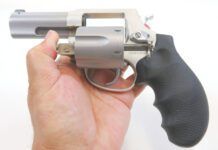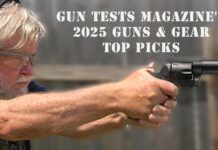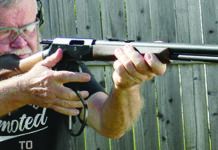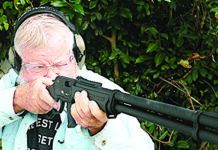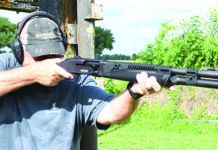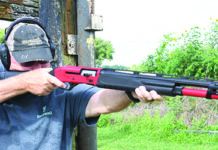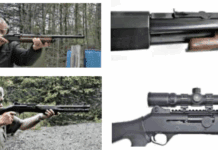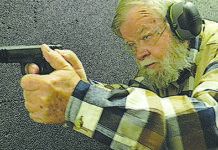Every December I survey the work Ben Brooks, R.K. Campbell, Roger Eckstine, Robert Sadowski, and Ralph Winingham have done in Gun Tests, with an eye toward selecting guns, accessories, and ammunition the magazine’s testers have endorsed. From these evaluations I pick the best from a full year’s worth of tests and distill summary recommendations for readers, who often use them as year-end shopping guides. These “best of” choices are a mixture of our original tests and other information I’ve compiled during the year. After the magazine’s FFLs sell high-rated test products to readers, I keep tabs on how many of those guns do over time, and if the firearms and accessories continue performing well, then I have confidence including them in this wrap-up. —Todd Woodard
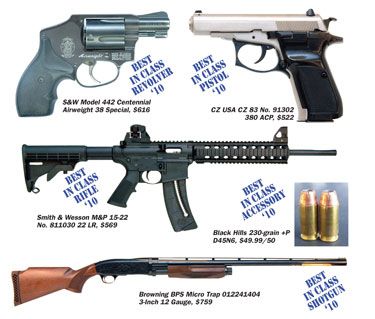
CZ USA CZ 83 No. 91302 380 ACP, $522
The CZ 83, now available from CZ USA, located in Kansas City, Kansas (www.cz-usa.com), has been in the catalog in one form or another since 1982. That’s when the Czechoslovakian military received its 380-caliber pistols. The Model 83 appeared the following year for civilian sales. The CZ 83 is also available chambered for 32 ACP. The 380-caliber models come finished in blued steel or satin stainless. The frame was also finished with a satin-nickel sheen, but other parts were glossy blue. The grips were black plastic panels that left the backstrap exposed.
Our Model 83 arrived with two steel-bodied magazines that held 12 rounds of ammunition staggered side by side above a removable steel basepad that seated flush to the bottom of the frame. Other notable characteristics were the externally mounted extractor, rear only cocking serrations on the slide and a white dot front sight blade. The rear sight, also showing white dots, was dovetailed into the slide and fixed with a small vertical pin.
The CZ 83 was blowback operated, wherein the 3.8-inch-long barrel was fixed to the frame. Unlike many other blowback pistols, the CZ 83 had a left-side lever that can be used to lock back the slide.
The trigger system offered both traditional double action (TDA) and single-action only (SAO) fire. Once the slide was moved to load the chamber, the safety could be applied with the hammer back for cocked and locked carry. Or, the hammer could be lowered for a first shot double action with single-action only shots to follow. Without a decocking lever in place the hammer needed to be lowered manually. This meant grasping the hammer and holding it back. Then, pressing the trigger until a click was heard. At this point the trigger was released but the hammer remained in our grasp. We gently lowered the hammer. Actually, once the click sounds and the trigger has been released there should be no danger of ignition. Thankfully, the hammer was properly shaped and large enough so that we didn’t feel our grip on the spur was ever in question. Plus, there was room for us to grasp the hammer with one finger wrapping partially around the hammer blocking the firing pin. We’re not sure the CZ 83 was actually meant to be carried with the hammer back at all times. Rather, the safety may best be applied at the conclusion of live fire for safe holstering. This would maintain a higher state of readiness should a safe situation take a turn for the worse. The CZ 83 held 12+1 rounds, making it the only high-capacity pistol in the test. It transmitted the least recoil while producing the most power. The magazine release was partially blocked by the contour of the grips, but shooter comfort and bold sight index made this gun easier to shoot.
Our Team Said: Compact and efficient, the CZ 83 may be the best example of a traditional double-action pistol we’ve tested.
Magnum Research PiCuda 22LR Graphite Pistol MLP22BN, $695
Typing PiCuda, the acronym for Pistol Barracuda, into the magnumresearch.com website search window revealed six different models. Three were chambered for 17 Mach 2 and three for 22LR. Both calibers were made with laminate stocks in colors Barracuda, Nutmeg, and Forest Camo. What may have led to the stall in manufacturing the PiCudas, which took place about one year ago, were ammunition difficulties for the Mach 2 editions. Admirably, Magnum Research got out in front of the problem by offering an exchange of Mach 2 PiCudas for 22LR models. Regarding the question of warranty service for a discontinued model, we would read this as positive.
Our PiCuda was fit with the Nutmeg-colored stock. Perhaps the most pressing question is, why does the PiCuda cost about $300 more? Well, to start, the scope mount is not going to come loose because it was machined as one piece with the receiver. The mount was elevated about one-half inch above the action by some pretty fancy machining. We really liked it. It was handsome, precise and shared the durable French grey anodized finish with the receiver.
There was no sling stud onto which we could attach a bipod, but there was an oversized bolt handle. Bolt action was enhanced by way of a “match bolt kit.” We didn’t have to brace the gun against our body to pull it back, and the bolt lock/release had been refined. It was a pleasure to use. A match trigger was installed that presented the same amount of resistance found on our stock Charger, but the movement was more refined, smoother, without grit or unnecessary takeup.
The 10-inch barrel consisted of a steel sleeve surrounded by graphite. The reason for this design was to provide a rigid barrel that dissipated heat quickly. Keeping a barrel cool is one way to avoid variation in point of impact over the course of a long shooting session.
One easy modification we would recommend would be to install a sling stud. This would allow for attaching a bipod or a sling for support. To fire the PiCuda standing, we chose to stabilize the weapon utilizing a push-pull hold between the grip and the support hand, which was placed on the forend of the stock. But we much preferred shooting from support.
At the range the PiCuda displayed a much different preference in terms of ammunition. The PiCuda would rather munch on the Remington Golden Bullets in the 525-round value pack. The Mini Mags HPs were printing groups ranging in size from 1.3 inches to 1.5 inches across, and the round-nosed CCIs were pretty consistent, landing 1.2-inch groups.
Firing the Remington ammunition we managed to shoot groups of 0.8, 0.9, 1.0, and 1.1 inches before landing a 1.5-inch group to spoil the fun. That the PiCuda only excelled firing one of our test rounds should not be discounted. Given our limited choice of test ammunition in a crowded field, we read this as direction towards other rounds that may provide greater accuracy.
Our Team Said: The extra cost was justified by the addition of high-grade parts, a superior finish, and the one-piece machined receiver with integrated scope mount. In fact, the PiCuda features several of the many hop-up parts that can be applied to a 10/22 action. In addition, it was obvious that many stock pieces were refined and hand-fit for improved operation. But without a significant leap in accuracy, the additional cost might cause some to grade it down a notch.
STI International Sentinel Premier 45 ACP, $2243
Georgetown, Texas-based STI International has built quite a reputation in competitive shooting, and the company’s pistols have become a frequent sight at events throughout the country. Their Sentinel Premier is the flagship model and carries both USPCA and ISPC certification. Our test gun arrived in a smallish plastic case. We found it contained our pistol, some small wrenches, plastic bushings, and a bushing wrench. We also found a single, but very nice, stainless steel Wilson Combat Elite 8-round magazine, which had viewing slots on each side of it.
The Sentinel Premier comes fully loaded with only a couple of options available. Our gun had one of them; hard-chrome plating which added $300 to its price tag. All of the metal components featured this finish, except for the sights. The sides of the slide were polished bright, with the frame a dull matte finish. Ambidextrous safety levers are also available for $45 as well, but much to our lefty tester’s dismay, our gun had only the single-lever version. The thumb lever was extended in length, and the edge had been smoothed to eliminate any sharp edge, with serrations on top to aid in its activation.
The STI has a ramped, fully supported barrel held in a place by a match-grade bushing. We noted that the muzzle of the Sentinel Premier was crowned to fit flush with the bushing, giving it a very clean appearance and also helping protect it from edge damage. The STI had both front and rear cocking grooves which were smartly formed, allowing the slide to be worked easily. The mag release button protruded far enough from the frame to be accessed freely, but not so much to be a magnet for accidental activation. The bottom of the grip frame had been ramped to act as a magazine guide to assist in reloading. There was 30-lpi checkering adorning both the front strap and mainspring housing, making for a very solid gripping area.
The sight picture on the STI had received extra treatment as well. The top of the slide had been flattened and grooves had been cut lengthwise to reduce glare from the bright finish. A fully adjustable Dawson/STI rear sight was coupled with a ramped STI/Trijicon front. Both sights had Tritium inserts, making it suitable for low light conditions, and were mounted low to reduce the risk of snagging. This combination of features proved to be very effective, and our testers all agreed that the STI provided the best overall sight picture of the three guns tested.
It was evident upon the first time we racked the slide that the Sentinel Premier was a well-fitted gun. Its assembly and recoil spring design allowed an easy cocking action. The trigger pull on the Sentinel Premier was a light and crisp 4 pounds. Overall, its action was precise, smooth, and refined, attributes we would expect from a gun in its price point.
The Sentinel Premier did not disappoint at the range either, racking up the best overall accuracy numbers with each ammo tested, including an average 0.8 inch group size with our Winchester 230-grain FMJ loading. Our testers felt the sight picture afforded by the STI allowed them to accurately line the gun up with the target. The light and responsive trigger also contributed to these results. Recoil was very manageable even though the STI was the lightest gun in our tests.
Our Team Said: We found that the STI delivered a high level of performance, and was capable as both a competition and carry gun.
Walther P22 WAP22003 22 LR, $375
The Walther P22 is a 3.4-inch-barrel double/single action pistol manufactured in Germany. Although it was small, it managed to have the feel of a more substantial frame. This was due to its solid ergonomics and a removable backstrap that could be sized to accommodate larger hands. The frontstrap on the polymer-framed gun had a finger swell slightly above its midpoint that created enough surface area to encompass almost all of our digits. An angled magazine surface took care of the bottom half of our pinky finger. This curved grip also helped the gun to point very naturally. The grip also had molded grooves on the frontstrap and stippling on the sides and backstrap to help secure one’s hold on the P22.
An additional inspection of the polymer-framed Walther revealed a rectangular trigger guard with three molded ribs on its front. The bottom of the trigger had two small levers on its rear face that acted as a magazine release. Walther owners recognize this configuration from other models, like the PPS and P99. It is a design that proved controversial among our testers. They either really liked it or didn’t care for it at all. The trigger face had three ribs running down its length, but the edges of the trigger were rounded.
A Picatinny-style rail with a single crosshatch adorned the bottom of the P22’s frame. It could accept the small Insight X2L, but the Surefire was much too large to fit it. The aluminum slide had both front and rear cocking serrations, and small ambidextrous safety levers adorned its rear corners. They function as safeties only; decocking is performed by putting the gun on safe, then “thumbing” the hammer while pulling the trigger. The top of the slide has ribs running down its length, which would normally be there to reduce glare when sighting the gun. However, we felt the look was more decorative, since the matte black finish was not reflective. A loaded-chamber indicator was also present.
Sights on the P22 consisted of a ramped white-dotted front sight and two white dots on the adjustable rear. The Walther P22 is a DA/SA design. The trigger pull was relatively smooth, breaking at a reasonable 9.6 pounds. Single action came in at a consistent 5.9 pounds.
On the range, the Walther P22 proved to be a pleasant, consistent performer. It wasn’t perfect, with three failures to feed, and one failure to extract in the early part of our accuracy testing. We did a quick clean and lube on the gun, and afterwards it ran through the rest of our testing without any further problems. Testers praised the double-action pull of the Walther, which was relatively smooth with a reasonable trigger-pull weight. The single-action performance was also consistent through our test sessions.
Our Team Said: The unanimous decision was that the P22 was a top performer, especially if you are current Walther owner.
Springfield Mil-Spec PB9108LP Parkerized 45 ACP, $753
The Single Action Shooting Society published rules for a special “side match” called the Wild Bunch match. You may have guessed that this match is in deference to the Sam Peckinpah western, The Wild Bunch. The movie is set in time just after the introduction of the Colt 1911, and much of the action takes place in revolutionary Mexico. The 1911 Colt is very much in evidence in this movie.
Interested competitors contacted Gun Tests with a request to test several of the likely 1911 45 automatics to rate which of the pistols may be the best buy for such competition. There are two classes set forth for 1911 handguns, which roughly correlate to the traditional and modern single-action class. The best of our five traditional GI-type handguns came from Springfield Armory.
As many of you are aware, the pistols in use in the Wild Bunch era were 1911s, not 1911A1 pistols. After World War I, the Army instigated an improvement program that led to the 1911A1. All 1911 handguns today are 1911A1 types, although we call them 1911s.
Since the Single Action Shooting Society specified lead bullets for these guns, the choices among factory ammunition are limited. We chose a proven 230-grain roundnose lead load from Black Hills. Black Hills also offers a 200-grain semiwadcutter we used during the test of these legacy guns.
We used a third combination, a handload using the Oregon Trail 200-grain semiwadcutter over 5.5 grains of WW 231, a proven accuracy load. It was essential each handgun perform well with these typical match loads.
The Mil-Spec pistol featured high-visibility sights and a lowered or scalloped ejection port. The pistol was delivered with the same attractive grips found on the stainless GI pistol. A bonus was a plastic holster and dual magazine carrier, as well as a spare magazine. The Mil-Spec seemed to be fitted better than the GI pistol, our team said. The controls were crisp and positive, and the trigger broke at a nice 4.25 pounds. The 1911s demand hand fitting, and some variances are allowable, but the Mil-Spec seemed to enjoy more hand fitting and attention than the GI pistol. Mil-Spec sights seem to offer less advantage to some shooters than others, but this group of raters all commented favorably on the Mil-Spec sights in comparison to the GI-type pistols. These sights proved well regulated for 230-grain ball, striking about 2 inches above the point of aim at 25 yards. This is the traditional sighting in measure for 1911 pistols, allowing a good chance of connecting with man-sized targets to 50 yards. The lighter-kicking 200-grain loads struck an inch low with the Mil-Spec.
Our Team Said: The Springfield Mil-Spec proved to be the most accurate pistol tested. We fired one remarkable 2-inch 25-yard group, with the average group just over 3 inches. This would be acceptable accuracy for more expensive pistols. There were no malfunctions of any kind. In our opinion, the pistol demonstrated ideal performance and accuracy. Improved sights and a great set of grips were among the bonus features. Accuracy, trigger compression and control function were flawless. Performance was not marred by a break-in period or by malfunction.
S&W Model 442 Centennial Airweight
38 Special, $400 (used); $616 (new, No. 162810)
The 38 snubnose revolver is a staple of murder mysteries, cop TV shows for many decades, and of real-life cops who need a good, light backup. Everyone over the age of, say, 40 has seen a snubby at one time or another. Today’s TV cops favor all manner of automatic pistols, so the snub 38 is not often seen. But that doesn’t mean it’s no good. The bottom line is, if all you have is a 38 Special snubnose with only five shots, you are a very long way from being unarmed. If you carry five more in a speed loader, well, what more could you want? S&W offers a machine-engraved version of the 442 for just over $900 MSRP, but it lacks the barrel rib of our test gun. Also, SKU #178041 is the newly made Centennial Airweight, unadorned and matte black with stainless cylinder, which lists for $640. Or you can buy our matte-black test gun—No. 162810 with a carbon-steel cylinder—for $616 new.
This mostly matte-black revolver had hard-rubber grips with a finger groove that most of us liked. The grip was comfortable in the hand, and although we could get only two fingers onto it securely, we had no trouble controlling the gun. The DA trigger was case colored, and had no serrations so the trigger finger could slide sideways during shooting, though we did not find that necessary nor desirable. Although the frame was aluminum and the cylinder and barrel were steel, the finish was extremely uniform all over. The right side of the frame had the Airweight name laser-etched into it along with the S&W logo, and all filled with white paint.
The gun opened by the usual S&W latch, which we found did not cut our fingers nor get in the way to any extent during our shooting tests. As with all older S&W snubbies, the empties were lifted only 0.625 inch out of the chambers, but if you had a clean chamber, the empties could generally be thrown out of the gun by working the ejector briskly. The ejector rod was steel, and formed the forward latch for the cylinder. The rear of the cylinder had the usual spring-loaded pin fitting into a hole in the rear of the frame for the latch.
The fronts of the cylinder were relatively sharp, though they could have been rounded to avoid cutting fabric or holster. The sights were bold and wide, but there was not enough room on the sides of the front sight blade, and it got lost easily during our fast shooting sessions.
On the range we found the Centennial shot close to its sights for elevation with all the test loads, and grouped about 2 inches to the left at 15 yards. With a few trial FBI loads from Buffalo Bore, the shots struck somewhat higher, but still on the paper. The Centennial Airweight did best with our handload, giving round groups that averaged 2.4 inches. The trigger of this gun was the best of the trio for deliberate slow fire. The trigger stacked to the letoff point, and we could then fine-tune our sight picture and finish the press. Still, our groups averaged around 4 inches at 15 yards.
Our Team Said: Overall, this revolver felt the best to our group, in part because it had the best DA trigger.
Smith & Wesson M&P 15-22 No. 811030 22 LR, $569
The first time one sees the Smith & Wesson M&P 15-22 the reaction might sound like this: “What kind of magazine is that?” The see-through relief and load assist lugs are a dead giveaway. But from the left-hand side of the carbine, there is little else that would lead you to believe it was anything but a patrol carbine with A2 sights and Picatinny rails on all four sides of the handguard. However, Smith & Wesson did see fit to leave off the flash hider, and the trigger guard was molded, sans bottom hinge, as one piece with the polymer receiver.
The right-hand side of the carbine showed a shorter ejection port than a centerfire model, but the bolt was worked by the charging handle. Of the replica features, this may have been our favorite overall. The magazine was the approximate size of a 30-rounder, but the magazine held 25 rounds of 22 LR. Residents of encumbered states are offered model number 811031. This is the Compliant version of the 15-22 and its shorter magazine holds only 10 rounds.
Owners of an M&P 15-22 will get a full lesson on the AR-15 manual of arms. Here is a list of standard black-gun characteristics: Six-position adjustable buttstock with solid mount sling loop. The pistol grip was bolted into place, not molded with the receiver. The magazine release was right-side only, index-finger operated. The safety was above the grip on the left side. Safety-on was parallel to the bore. The gun was ready to fire when the lever was pointing straight up. The bolt release was another standard AR design. Each of these parts looked like they could be fit on to any other AR-15.
All guns work better when they are maintained, and the easier it is to clean and lubricate a weapon the more often it will be done. No other semiautomatic rifle or carbine breaks down as easily as an AR-15, and the M&P 15-22 was field-stripped in exactly the same manner.
The receiver was a flat-top style, with a rail that stretched continuously from the charging handle to the tip of the 10-inch-long polymer handguard. About 5.5 inches of straight-wall barrel was left uncovered. The barrel was medium gauge and fixed rather than free-floated, gaining support via a bushing seated at the very front of the handguard. Sights front and rear were non-folding and held in place by heavy knurled screws. The front unit was the tower style with a square blade that was adjustable for height by depressing the spring-loaded detent peg and turning the blade. The rear sight was adjustable for windage and elevation, and two apertures of different size could be rotated into place.
From the 25-yard line, Federal Champion rounds shot groups that averaged about 1.1 inches across, most of the groups we measured firing our Value Pack rounds were less than 1 inch across. The CCI Green Tag rounds produced groups that measured 0.6 inch, 0.7 inch, and three more groups barely 0.9 inches across. From the 50-yard line, our Green Tag groups ranged from 0.6 and 1.1 inches center to center. There were no malfunctions.
Our Team Said: Perhaps what we liked best about this carbine was that it offered a cheap day of shooting with a weapon as close to an AR-15 as we could get. The M&P 15-22 was light enough, and thanks to its adjustable stock, ideal for small shooters. The subdued recoil and noise of the rimfire ammunition make it even easier to use the AR platform.
CMP-2 Inland Carbine 30 US Carbine, $495
The M1 carbine was the most prolific U.S. weapon of the WWII era, with six-odd million made, and it’s still very popular today. It employs an anemic round by rifle standards, but—per its design—its cartridge is at least as powerful as most handgun rounds. Today’s buyer of a genuine WWII-era or Korean War era carbine will probably need to spend around a thousand dollars, give or take a few hundred, for a reasonable example. On GunBroker we saw prices from about $750 to$1400, depending on condition and rarity. However, if you’re qualified, and if you hurry, you may be able to get a decent carbine for about $420-675, through the Civilian Marksmanship Program (CMP) sales. This outlet used to be called the DCM, Director of Civilian Marksmanship, run by the U.S. government, but that program is now in private hands. However, due to the nature of the program, the CMP carbines may be in very short supply by the time this report appears in print.
Generally speaking, here’s what we think. Those who like shooting military type firearms really owe it to themselves to have an M1 carbine. They’re a lot of fun. Good ones need not break the bank, but in an era where the SKS rifles that used to go begging at gun shows for $85 now bring upwards of $400, the price of an M1 carbine is not outlandish, even at the over-a-grand mark. We suggest you act soon, particularly if you want one from the CMP. They’re going fast.
Do you qualify for a CMP firearm purchase? Taking the CMP requirements straight from the website (www.thecmp.org), “By law, the CMP can sell surplus military firearms, ammunition, parts and other items only to members of CMP-affiliated clubs who are also U.S. citizens, over 18 years of age and… legally eligible to purchase a firearm.” Reviewed in the December 2009 issue, our A+ carbine came from the CMP, the Inland CMP-2, $495. The CMP-2 had a swinging-arm or “flip” type safety, which requires pulling a small lever rearward to put the gun into the firing position. This is easily accomplished with the right index finger, by right handers, and fairly easily by the trigger finger of lefties. The gun had a stepped, windage-adjustable rear sight and a stamped base for the adjustable rear sight with a wing-protected front sight.
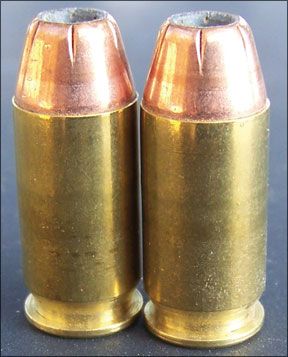
We tested with three types of 30 US Carbine FMJ “ball” ammunition, all of it 110-grain loads. It was from Sellier & Bellot, American Eagle, and original U.S. Mil-Spec ball (head stamped LC71). Because the CMP carbine came without magazines, we used an original Winchester 15-round magazine for all our testing.
By a slight amount, it turned in the best accuracy of the test, and it also had the best trigger, breaking creepily just over 5.5 pounds. The walnut stock had fewer dings than the other CMP rifle, largely the luck of the draw, we’re sure. Again the bore looked like a mirror, and the rifling was pretty sharp right out to the crown. The edges of the stock were all quite sharp, and a crossed-cannon cartouche on the right side of the butt stock was still partly visible. The bolt stayed open well. This one had the flip safety, bayonet lug, and round bolt.
The more we shot the Inland the more we liked it, because it made the best groups of the four carbines. It even shot the old U.S. Ball ammo well, getting groups just over 2 inches. The Parkerizing all seemed to match, except that the bolt was a touch darker. Even the butt plate was in fine condition, with excellent finish. We liked the flip safety and the bayonet lug, which mated well with the adjustable sight.
Our Team Said: This was our first choice, especially in light of its price. Although luck plays a part in what you get from the CMP, you could hardly go wrong if you get a carbine like this one through a private seller, since the CMP sold out of Inlands last year.
Ruger SR-556FB 5.56x45mm NATO 223 Rem., $1995
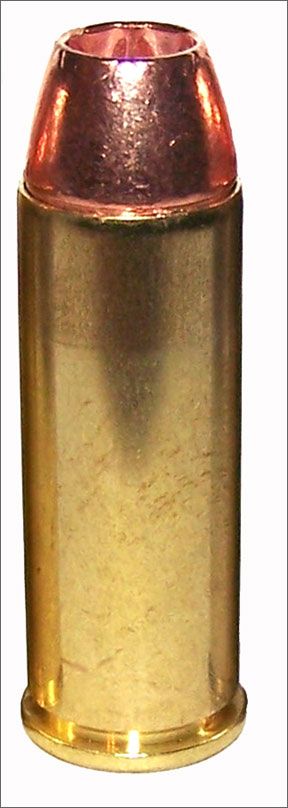
When the company rolled out the SR-556 in May 2009, it was the company’s first foray into an increasingly crowded and competitive segment. And just looking at the feature set, including the two-stage piston-driven action, shows us the company put a lot of careful thought into the initial build. To begin: The SR-556FB had a heavy contour, 16.12-inch chrome-lined barrel forged from Mil-Spec 41V45 chrome-moly-vanadium steel. The 0.700-inch-thick barrel had a 1:9 twist rate and was capped with an AC-556 flash suppressor. The barrel and gas block were chrome lined, while the bolt, bolt carrier, and extractor were chrome plated. The piston-driven transfer rod was electroless nickel/Teflon coated. The flash hider and the exterior of the barrel, gas block, and regulator were manganese-phosphate coated. All aluminum parts were Mil-Spec hard-coat anodized.
The gun specs say the SR-556 comes with a one-piece 10-inch Troy Industries Quad Rail Handguard, but ours measured nearly 11 inches in length. Added to the Mil-Spec rail on top of the receiver, we counted almost 50 inches of rail surface to mount flashlights, lasers, grips, or perhaps a small barbecue pit. The handguard is pinned to the upper receiver and provides a mount for the piston-driven transfer rod. Three Troy rail covers provide a comfortable gripping surface.
On top, the SR-556FB is equipped with Troy Industries Folding BattleSights (thus the FB in the name), which our test team lauded above. They co-witness with Mil-Spec optics, and are easily removed or replaced. Pushing in a spring-loaded button on the right side of the sights allows them to be folded down or flipped up with one hand. The windage-adjustable rear sight includes two apertures, and the protected HK-style front sight is elevation adjustable.
At the butt is a six-position telescoping M4-style buttstock, but the Hogue Monogrip rubber pistol grip provides a better trigger-hand shooting surface than the other guns, our team thought.
Ruger’s published specs for the gun say it weighs “7 lbs. 15 oz.” without a magazine, but ours dinged the scale at 8.4 pounds without a magazine and 9.4 pounds with a loaded 30-round Magpul PMAG magazine in the maw. The gun came in a padded Ruger-branded carry case with hook-and-loop fasteners and internal magazine pockets. Ruger says the gun ships with three 30-round Magpul PMAGs, but our gun had only two.
Of course, the heart of the gun is the patent-pending two-stage piston-driven operating system. Ruger claims it delivers a “smooth power delivery stroke to the action and vents combustion residue out of the bottom of the gas block.” The four-position adjustable gas regulator allows the operator to tune the rifle to specific ammunition and rifle conditions. The Ruger turned in the best performance with the SSA ammo (1.11 inch AGR), but it also had good results with the Federal FMJs. The Troy rail system easily
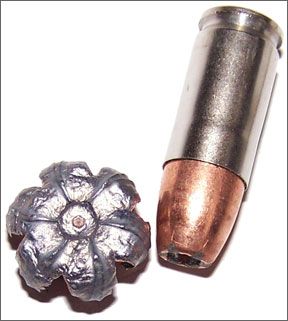
accommodated a riflescope, red dot, and laser.
Our Team Said: The Ruger offers a heckuva lot of value. The Ruger’s rail system and sights are great choices. The Ruger shot very well with the Federals, so with the right ammo, accuracy is a given.
Browning BPS Micro Trap 012241404
3-Inch 12 Gauge, $759
In the process of acquiring a Browning Pump Shotgun, or BPS for short, we learned that the full-size BPS Trap was temporarily out of stock. So we settled for the Micro Trap, a so-called youth model. We decided that the Micro Trap was indeed suitable because the only differences were barrel length (28 inches versus 30 inches), and a shorter length of pull. Reducing length of pull is undoubtedly the most popular modification applied to a shotgun. So, to our way of thinking, we were getting a freebie rather than a penalty. The buttstock of the Micro Trap displayed a Monte Carlo profile, which served to raise the comb. The pistol grip was checkered, and the leading edge of the comb was relieved for the palm. Browning calls its semi-gloss finish “satin walnut.” The grain of the wood was visible, running horizontally from the buttpad to the receiver. The buttpad was made from hard rubber, but thanks to a generous amount of relief, it did a good job of soaking up recoil. The polished-blue receiver was engraved with floral scroll work that surrounded a scene with pheasants on one side and ducks on the other.
The safety was located atop the rear surface of the receiver and was best controlled by the thumb. The two positions were rearward for on-Safe and forward to Fire. Together with the stock that showed only the slightest cast off to the right, the top-mounted safety further increased the ambidextrous appeal of the Micro Trap.
The trigger, which we measured as presenting about 6 pounds of resistance, was gold in color. The slide release was located on the left side of the receiver just rear of the trigger guard, and its operation was smooth and fault proof. The barrel was topped with a high vented rib about 0.4 inch wide that featured a small white mid bead, a light-gathering filament at the muzzle and a checkered surface to reduce glare. Beneath the barrel was a dual-action-bar slide. The satin walnut fore end was full length. The lower portion of the fore end was checkered, and about two-thirds of the upper surface was indented to further accommodate grip. The lower rear portion of the slide was relieved so that when the slide was fully to the rear the sides overlapped the receiver but
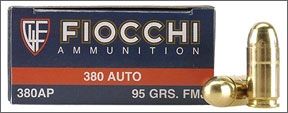
did not block the ejection port.
There was a shell stop located inside the ejection port that can be used to empty the magazine manually without working the slide. One interesting feature was the magazine cut-off. Located where the magazine mates with the receiver, the cut-off switch surrounded the magazine tube. With the selector pointing to the letter “R,” rounds cycled cleanly from the magazine tube to the chamber. Rotated to the letter “S,” working the slide would no longer pull rounds from the magazine. Our Browning readily accepted rounds loaded by hand directly through the loading gate. This proved ideal for shooting trap singles.
Of the three supplied chokes (Modified, Improved Modified, and Full), we chose to pattern and shoot trap with the Improved Modified choke. The BPS Micro Trap patterned nearly 80% of the shot above our point of aim.
At the 16-yard line we were immediately struck by how much softer the Browning shot than our other guns. This could be credited to the ventilated buttpad, but we think also it was a matter of the shorter length of pull contributing to a better fit. The BPS Micro steered easily but had enough weight so that its inertia contributed to a smooth swing and follow through. The gun felt well balanced, and it was easy to get a solid mount. The buttpad found its place, and it wasn’t difficult to level our eyes when mounting the stock.
Our Team Said: The fact is that most shooters will modify the length of pull as a critical part of the fitting process. The Micro Trap will likely delete this costly step or reduce it to fine tuning by changing the buttpad. We liked the Browning Invector Plus chokes, so there is a lot of flexibility in terms of shot enhancement available for this gun. The short-stroke pump action was definitely a plus for our testers.
H&R Pardner Pump-Action 12-Gauge
Pump Shotgun, $200
The pump action is a very popular shotgun type, mainly for its ease of operation and its ruggedness. While a self-loader may be a bit faster in trained hands, the point is debatable. Expensive autoloaders are reliable, but in the end a dirty or well-used pump is always more reliable than a dirty autoloader. The H&R Pardner is a basic copy of the Remington 870 design beneath the humpback receiver, but we had to cast aside any preconceived notions of the base platform because the Pardner is completely different from its stablemate.We bought the gun at Academy Sports, a giant sporting chain that offers rifles, pistols, and shotguns as well as other sporting goods, and the retailer sometimes has the Pardner on sale for $180.
Our team gathered and shot the gun using 2.75-inch Winchester Super Target loads (1-ounce charge of No. 8 shot, 2.75-dram equivalent, 1180 fps muzzle velocity) and also a new steel trap load, the Winchester Xpert Game/Target load WE12GT7, a 2.75-inch 12 gauge with 11⁄8 ounces of No. 7s, Max dram, developing 1280 fps, according to Winchester.
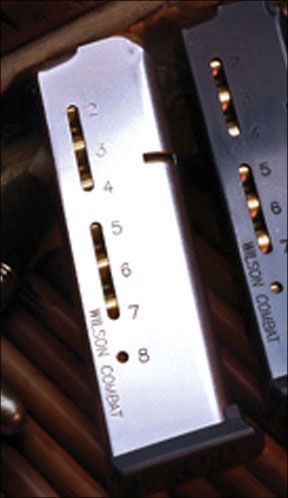
When we purchased this shotgun, we grumbled that it was not on sale and cost twenty extra bucks. After the test, the primary rater decided he would not sell this shotgun. We didn’t pay much, and it would not command a good trade in on the next project. We did not cherry pick a Pardner, we brought home an example wrapped in plastic. The clerk opened the box, confirmed the serial number, and we were on our way.
The fit and finish of the Pardner were good, our team said. The blue on the receiver was matte finished. The fit to the metal was good. The fore end was good and tight. The recoil pad was a webbed type that absorbed recoil well. The barrel rib was well done with a single bead. A plus for turkey hunters or short-range deer hunters was that the Pardner is drilled and tapped for a scope mount. That would be a tie breaker for some buyers.
Elsewhere, the trigger of the Pardner was crisp enough and broke at 5 pounds. When loading and firing, we encountered no surprises. The firing tests went well. Even with heavy trap loads, the recoil pad did a good job of diminishing felt recoil. We had a minor complaint from some of the raters, and this depended upon shooting style. The top of the stock was a bit sharp, and while never painful, it could have been better designed. Otherwise, the Pardner was very comfortable to fire. The crossbolt safety was located in the rear of the trigger guard. This was ideal for rapid manipulation and may be managed by a left-handed shooter with a little practice.
Our Team Said: We feel that the Pardner was designed to sell at a price point most people could afford, and H&R and their Chinese contractors have done a good job on the gun. When both are on sale at Academy Sports, the $10 in price differential very much favors the Pardner. The fit and finish were good, although the receiver was a brighter blue than the matte finish barrel. This shotgun was handy to fire and use. The mechanical resemblance to the Remington was obvious, but the humpback receiver gives the Pardner a distinctive appearance. For the price, we could not register a complaint. The superior safety, the ability to mount a scope, the superior recoil pad, and the well-fitted wood furniture were advantages that easily gave the Pardner a win over the Maverick.
CZ Kadet Adapter No. 01610 22 LR, $412
Kimber Rimfire Conversion Kit 22 LR, $330
Today’s centerfire shooter who wants to save ammo money, or just plain wants to shoot a lot more for the same money, can buy 22 conversions that replace the slide with a more appropriate one, generally of lighter weight. In the case of our two test units for this report, the slides were fitted with excellent adjustable sights and excellent barrels. Changing centerfire to rimfire involved only taking off the original slide and replacing it with the 22 conversion unit, securing it in place with the normal cross pin, plugging in a 22-caliber magazine, and bang, you’re done. For this test we secured conversions for the CZ 75, called the Kadet Adapter ($412), and the Kimber Rimfire Target conversion for 1911s ($330).
The CZ 75 Kadet 22 LR conversion was a well-made unit fit easily onto the CZ, and gave the same overall look and balance. An important point about the CZ conversion is that it uses a fairly heavy slide/barrel assembly to retain the original weight and balance of the piece in 9mm configuration, and then uses a separate sliding breech, much like that on the S&W Model 41, to cycle the rounds in and out and recock the hammer. The magazine capacity was only 10 rounds for the 22 version, compared with 16 for the 9mm.
Another, very pleasant, difference was the sight setup fitted to the Kadet. The rear was fully adjustable, the front was slanted like the full-size version, the sight picture was outstanding, and both front and rear had tritium inserts to permit low-light practice.
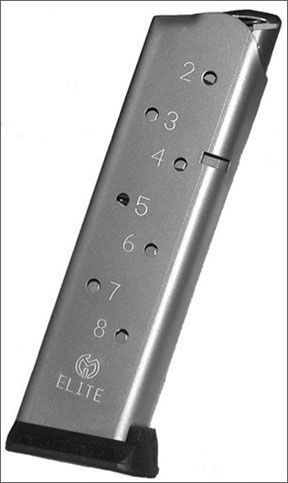
We installed the Kadet onto our Model 75B, which took only a few minutes. Even more to our liking was the conversion unit’s outstanding accuracy. The sample target that came with the unit showed the fine potential of the Kadet, and we were able to match the factory results with several of our groups. The sights as received were precisely aligned with the center of our 15-yard target. As noted in the original test of the 9mm, the trigger of the CZ needed work. A really fine trigger job would benefit this gun immensely in both calibers.
Kimber’s conversion package included a very light slide fitted with outstanding, matte-blued, fully adjustable, no-nonsense target sights. The front sight was slanted slightly rearward, just the setup one wants on a target pistol, and for that purpose we could hardly fault Kimber. One of the more serious uses for this conversion would be for NRA competition, which would give the exact same trigger pull for all three stages of a three-gun match, which would include rimfire, centerfire, and 45 ACP.
Also available in all-black, the Kimber’s “silver” slide had a durable matte-white finish that was put on with obvious care and pride. The machining inside and out were flawless. The various parts that made up the unit were all carefully matched and well finished in a dull, off-white, glare-free color. The slide had cleanly cut front serrations for press checking as well as the normal ones at the back. The fit of all the various parts was impeccable. The 1:16-twist barrel had a recessed crown for greater protection. As with the CZ, once the gun got going, there were exactly no problems with it whatsoever. Accuracy was on a par with what we had received with the CZ Kadet, best groups running just over an inch for five shots at 15 yards.
Our Team Said: The Kadet’s price was fair for the quality, and if you shoot a lot, the conversion will pay for itself in money saved over the cost of centerfire ammunition, especially at today’s prices.
Our Team Said: We were mighty pleased with the Kimber Target Conversion. This was another winner, one that we thought any owner of a single-stack 1911 could put to very good use. We suspect all makers of 22 conversions will be very busy in the foreseeable future. One new 1911 shooter who stopped by our test range was amazed that such things as these conversions existed, and was pleasantly surprised at the cost of them.
Bushnell Elite 3200 3-9x40mm DOA 600
Model No. 323940B, $359
Riflescopes with ballistic reticles purportedly take the guesswork out of long-distance shooting by combining a typical crosshair with additional aiming points at set distances. The reticles are calibrated to popular hunting cartridges with muzzle velocities in the range of 2800 to 3000 fps or more. The usual suspects fall into that range—243, 6mm, 25-06, 270, 308, 30-06, 7mm Rem. Mag., 300 Win. Mag., including a slew of others.
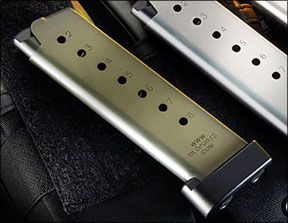
We mounted Bushnell’s Elite 3200 with DOA 600 reticle to a Kimber model 8400 Classic in 30-06, which is a perfect example of a hunting rifle/caliber combination likely to be found from Montana to Maine. Since the 30-06 is common caliber and is available in a number of bullet styles and weights, we assumed it would fit the scope manufacturers’ criteria as a “popular caliber” as stated in their manuals.
Out of the box the Elite 3200 sported lens covers with a bungee cord that was fine for transporting and storage but not suitable for field use. Rainguard is the company’s proprietary coating that helps in light transmission and protects against fogging and condensation. The freezer/warm water test had no effect, with droplets of water wiping off with a lens cloth and leaving no residue. When brought inside from 30F temperatures, the lens fogged, as did the other scopes, but it quickly regained its ability to see faster than the others, we noticed.
The power magnification ring provided a good grip and the right amount of resistance when turning it barehanded or when wearing gloves. The setting was easy to read, with a dot on the tube aligning with the number on the power scale. Windage and elevation caps had rounded edges, giving it a smooth look.
Bushnell calls its ballistic reticle the DOA (Dead On Accurate) 600. It consists of a main duplex-style crosshairs and five additional aiming points. Four additional aiming points combine MOA dots with shorter horizontal crosshairs, and, finally, a short duplex in the 6-o’clock position. Per the manual, the main crosshair was zeroed to 100 yards, thus calibrating the four MOA dot/crosshair combinations to 200, 300, 400, and 500 yards, and the bottom post at 650 yards. To use the additional aiming points, hunters must remember to set the power ring to maximum magnification.
Built into the DOA 600 is a distance estimator called the Rack Bracket System that consists of vertical hash marks on the horizontal crosshairs of the MOA dots. The hash marks are set at 17 in. and 24 in., which are the average width of a mature whitetail’s and mule deer’s ears, respectively. To use this feature, the hunter must find a deer facing or looking directly away from the hunter. Bushnell claims that if the ears fit into the bracket, you have an accurate estimation of range. The Rack Bracket was on the 200, 300, 400, and 500 MOA-dot/crosshair combinations.
Our ammunition was not listed in the manual, but the manual did direct us to a list on the Bushnell website. Ammo was listed by cartridge brand and by bullet brands for handloaders. The Bushnell performed well. Using the 200-yard dot, bullets hit the target dead on. Using the other aiming points, bullets grouped at a height consistent to the bullet’s path for the ranges.
Our Team Said: At first glance the DOA 600 reticle looked like a cross between a wiring schematic and totem pole. Luckily, the manual helped quickly decipher it. Testers liked that they could place the black dots on the target, and that’s where the bullet would hit. The horizontal crosshairs also helped shooters get back on target if they lost the black dot on a dark target. The team liked the range-estimating feature but wondered how it would work on game of different sizes. But the range estimator was still better than outright guessing.
-
Speer Gold Dot 45 ACP 200-grain No. 23969, $23.99/20
-
Cor-Bon Self-Defense 45 ACP JHP 230-grain SD45230, $29.48/20
-
Black Hills 45 ACP 230-grain +P D45N6, $49.99/50
-
Cor-Bon 45 Colt 225-Grain DPX45C225 +P, $51.39/20
-
Speer Gold Dot 9mm 115-Grain No. 23614, $27.95
-
Fiocchi 9mm 115-grain XTP No. 9XTP, $22.79/50
-
Fiocchi 9mm 124-Grain XTP No. 9XTPC, $24.65/50
-
We have tested several types of ammunition in 2010, and have compiled the best of the best selections here. When the debate turns to small and large calibers and high velocity versus a big bullet, we tend to yawn. Been there, done that, and shot lots of game. Studied plenty of personal-defense shootings as well. Our primary ammo tester is often consulted by the crime-scene team in one of the busiest areas in a high-crime area in the Southeast. We have not seen it all, but we have a good idea of what occurs when a bullet meets a threat or a game animal.
All in, we prefer the big-bore cartridge. The slow and heavy 230-grain 45 ACP has exhibited excellent results and proven consistently effective over the course of 100 years. Among 45 ACP +P class ammunition, we wished to answer two questions: Does the +P offer improved performance?, and Which are the best examples? One of our picks was the Speer Gold Dot 200-grain No. 23969, $23.99/20. This is our No. 1 pick among the lower-weight 45 ACP +P bullets. The Cor-Bon Self-Defense JHP 230-grain SD45230, $29.48/20,is Cor-Bon’s answer to the need for a heavier bullet for law enforcement use and for use against felons who may be heavily clothed. The Black Hills 230-grain +P D45N6, $49.99/50, was once advertised as the Mack truck of 45 ACP loads. The Black Hills load is designed to offer maximum penetration (13.5 inches, with 0.72 inch expansion) with the Hornady XTP bullet. The Black Hills load shown at left showed the most penetration of any load tested and the best accuracy.
When we tested 45 Colt (not ACP) rounds, the Cor-Bon 45 Colt 225-Grain DPX45C225 +P, $51.39/20 (right), was head and shoulders above the rest, with more than 17 inches of penetration and the all-copper bullet expanding to 0.85 inch, almost twice its unfired size. There was no loss of bullet weight after expansion and penetration. This load is not only suitable for defense against humans, it would be useful against the big cats, feral dogs, and the smaller bears. The DPX is also very accurate. The only drawback in performance is recoil. Our resident single-action fan reports that the load kicks less than his benchmark 250-grain/1000-fps load, but neither is something you wish to fire in large quantifies at a setting. In range tests with the double-action revolver, we were able to achieve good results and reasonably rapid double-action pairs. This load is worth mastering, even though it costs nearly twice what some of the others cost. You have to ask if that one shot you may have to make during a critical incident is worth the expense.
Unquestionably the most popular military handgun cartridge of all time is the 9mm Luger. The question is, is the 9mm a good fight stopper? That question has many answers, and it depends upon who is doing the asking. With the shortcomings and advantages of the 9mm mapped out, we chose the cartridge for close scrutiny in wound ballistics. One round earned an A+ grade, the Speer Gold Dot 115-Grain No. 23614, $27.95 (right). Purchased at a discount price of around $20, the Gold Dot is among the first bullets designed specifically to meet the FBI criteria for expansion and penetration. The Gold Dot expanded more than any other bullet tested. Accuracy was good, and weight retention excellent. Based on a combination of retained weight and expansion, this is the front-running load, in our view.
Two others were Grade A loads. The Fiocchi 115-grain XTP No. 9XTP, $22.79/50, uses the proven Hornady XTP bullet. This loading gave good accuracy and produced a good balance of expansion and penetration. When accuracy and quality control are figured, the Fiocchi load looks very good. Expansion is not radical, but is solid and repeatable. This is a 50-round box of high-quality ammunition, allowing a decent amount of ammo for proofing the pistol and with a gun load remaining. This makes the Fiocchi a Best Buy.
Also from Fiocchi was the company’s 124-Grain XTP No. 9XTPC, $24.65/50. It is similar to the 115-grain load, but with greater penetration. Expansion was good, and retained weight ideal at 100%. Very consistent and very accurate. If you prefer a balance of expansion and penetration that favors penetration, the 124-grain XTP looks good. At the price, it’s another Best Buy.
Among the hot topics for discussion these days is the 380 ACP cartridge, more than one hundred years old and among the first of the modern smallbore pistol cartridges. A recent question we fielded was ammunition choice for the 380 ACP. A very experienced reader was concerned with penetration. If the JHP would not be counted on for penetration, he asked, would he be better off to load the pistol with full-metal-jacket ammunition? Our testers came away from a test of 380s with an overall recommendation to deploy at least a 9mm Luger or 38 Special-caliber handgun.
However, if you already have a 380 pistol, you are not interested in 38 Sp. performance. If you deploy a 380 ACP pistol, we believe that the best choice is a FMJ load to ensure penetration in more situations in which a JHP might fail. Thus, our first pick among 380 ACP self-defense rounds was the FMJ Fiocchi FMJ 95-grain No. 380FMJB, $22.50/50. While any load would have sufficed as a test for FMJ loads, Fiocchi is usually a little faster than most and often produces good accuracy. However, we were surprised. The 9mm ball and 45 ball produces up to 30 inches of penetration in gelatin. Some feel that water is harder on bullets and that water will make bullets separate that will not separate in gelatin. However, 14 inches is short penetration for a 9mm/38 nonexpanding load. Just the same, this is a recommended load for personal defense. Several of our raters would load this one and hope for the best.
Among the JHPs, we preferred the Speer Gold Dot 90-gr. No. 23606, $17.99/20. The Gold Dot is an extraordinary bullet design well suited to most calibers. With an average velocity of 936 fps, the Gold Dot penetrated to exactly the same average depth as the Hydra-Shok. Even though water is hard on any bullet, the Gold Dot held together with excellent weight retention. When all things are considered, the Speer 90-grain Gold Dot had as much penetration or more than any other JHP, more expansion by a margin than the bullets with adequate expansion, excellent accuracy, and a clean powder burn, and a low price, making it a Best Buy.
1210-MAGNUM-RESEARCH-PICUDA.pdf
1210-SMITH-WESSON-MP-15-22.pdf
1210-HARRINGTON-RICHARDSON.pdf




